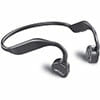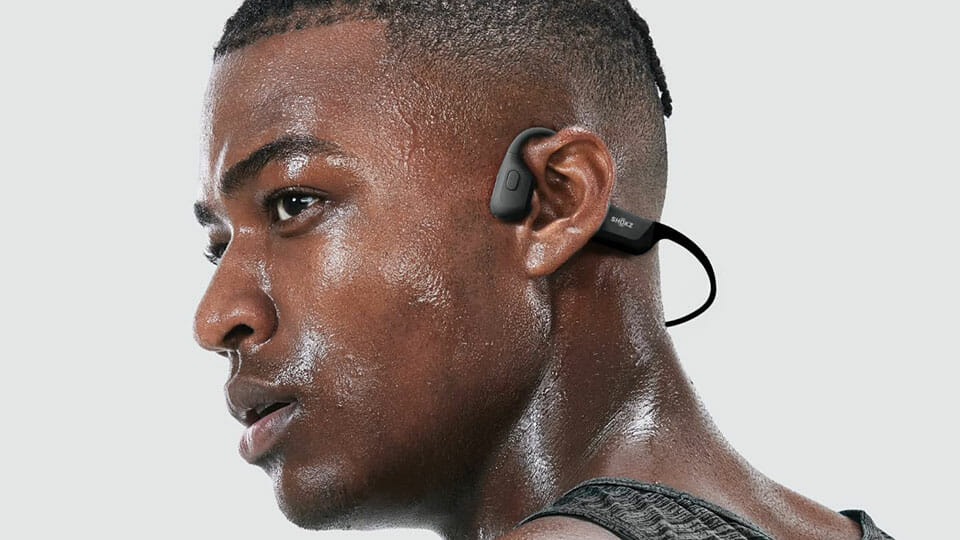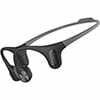If you’re looking for an alternative to regular headphones, here are the best bone-conduction headphones in 2023.
Bone conduction headphones sound almost as good as normal headphones, though not the same (more on that below).
On the other hand, they have top-notch fit, comfort, high durability and offer perfect awareness of surroundings.
Check them below:
| Rating | Price | Battery | Water protection | Connection | More info | |
|---|---|---|---|---|---|---|
|
Shokz OpenRun Pro
Best overall

|
4.5
|
Under $180
|
10 hours
|
IP55
|
Bluetooth 5.1
|
|
|
Mojawa Run Plus
Runner-up

|
4.6
|
Under $160
|
8.5 hours
|
IP68
|
Bluetooth 5.2
|
|
|
4.6
|
Under $160
|
8 hours
|
IP67
|
Bluetooth 5.0
|
||
|
4.6
|
Under $120
|
7 hours
|
IP55
|
Bluetooth 4.2
|
||
|
4.1
|
Under $90
|
5.5 hours
|
IP67
|
Bluetooth 5.2
|
||
|
4.6
|
Under $80
|
6 hours
|
IP55
|
Bluetooth 5.0
|
||
|
4.5
|
Under $160
|
16 hours (talk), 8h (music)
|
IP55
|
Bluetooth 5.0
|
||
|
3.5
|
Under $90
|
11 hours
|
IPX4
|
Bluetooth 5.0
|
||
|
Vidonn F1 Titanium
Best budget

|
4.1
|
Under $50
|
6 hours
|
IP55
|
Bluetooth 5.0
|
Wireless bone-conduction headphones are an exciting alternative to regular headphones.
Unlike traditional headphones, they send vibrations through your temporal bones to your ears (leaving your ears open), offering a unique way to experience sound.
They’re an especially suitable replacement for workout headphones. And lately, they’ve gotten better than ever before (thanks to Shokz).
How does bone conduction work?
Simple explanation: Bone conduction headphones make sound travel through your bones, directly reaching your inner ear, so you can hear the music without blocking your ears.
It’s why your voice sounds different…
Did you know you hear your own voice deeper than it actually is because bone conducts lower frequencies better than air? That’s why your voice sounds different than you expect.
See the best bone-conduction headphones below.
Related:
Best waterproof headphones for swimming
The Advantages & Disadvantages of Bone Conduction Headphones
There are a couple of things you have to know:
With an open-ear design, you remain aware of background noises
Because you leave your ear canal open, you still hear your surroundings. This is especially useful for running in a city, cycling, or anywhere else you want to hear loud noises.
Amazing fit and comfort
For the same reason, they feel amazingly comfortable. There are no earpads or eartips that would touch your skin. They lightly sit next to your ears which is much less bothersome.
The fit is also best-in-class. Usually, they come in a lightweight ear hook design. Once you put them on, they stay there, no matter the head shapes.
Highly durable
Because they are not using regular drivers, there is no air canal for sound waves. This makes them much easier to waterproof.
For that reason, most come with a certified high IP rating which means high dust and water protection.
Mediocre sound quality
The biggest caveat is their lack of bass. Due to different technology, the music transmission isn’t as clear. The details are a bit muffled, and they lack the deep-end rumble.
Though you can still enjoy music and listen to audiobooks.
Learn everything you have to know about bone conduction headphones and how they compare to traditional headphones.
The Best Bone Conduction Headphones
1. Shokz OpenRun Pro

The best in the bone conduction headphones market today.
- Fun sound quality with more bass than other bone-conducting headphones
- Long 10-hour battery life with quick charging (0-100% in 1 hour)
- Ergonomic and lightweight, Comfortable and stable fit for all activity
- Vibrating transducers can be annoying
- Proprietary charging cable
While bone conduction headphones aren’t known for audiophile sound quality, the OpenRun Pro boast some impressive results.
Newly renamed Shokz (previously AfterShokz) have managed to boost the bass response, making your favorite tunes sound fuller and with punchier bass.
However, that comes at the cost of slightly more noticeable vibrations. Thankfully, they’re only distracting when playing near full volume.
Otherwise, Shokz OpenRun Pro offer the same quality as the OpenRun (Aeropex) model. They’re as comfortable and lightweight, so you can easily wear them on longer jogs, while Bluetooth 5.1 maintains a stable connection.
Furthermore, the new bone conduction headphones have 10 hours of battery life and fast charging support. Also, they’re IP55 rated and fully resistant to sweat while also having the ability to deflect dirt.
2. Mojawa Run Plus

Mojawa Run Plus are one of the best-sounding bone-conduction headphones and a great value.
- Most balanced sound from bone-conductive headphones
- Stable fit, suitable for intense sports activities
- Onboard MP3 player for outdoor runners & swimmers
- Quality build with an IP68 rating
- Bluetooth multipoint support
- Mediocre call quality muffles your voice
- Pretty noticeable bass distortion
Run Plus are one of the best-sounding headphones of this type. They’re the lightest on bass, but they provide a much more natural and clear overall sound instead.
Inside the app, you can toggle between different EQ presets to add more bass or increase voice clarity. Although they’re a bit muffled when making phone calls.
Thanks to an IP68 rating and onboard storage with 32GB of space, the Run Plus are ideal for swimmers and outdoor runner who dislike taking a phone with them.
The battery life of almost 9 hours per charge is nothing groundbreaking, but it should suffice for at least 2 lengthy workouts.
3. Shokz OpenRun (rebranded AfterShokz Aeropex)

Slightly old but still among the best bone-conduction headphones out there.
Shokz OpenRun are a household name in the bone conduction headphone market. As they don’t cover your ear lobes, you can still hear what’s happening around you while listening to music.
Shokz OpenRun (AfterShokz Aeropex) review
- Stable fit for all types of sports
- Perfect environment awareness due to open-ear design
- Lightweight (almost 30% lighter than Air)
- Waterproof and dustproof (IP67)
- Good battery life (8 hours)
- Improved bass response from previous models
- Vibrating transducers might be annoying
- Sound quality is suffering (compared to regular earphones)
- Lack of bass
These bone conduction headphones have improved bass from the other AfterShokz bone conduction models, but it’s no high-fidelity sound. These use PremiumPitch 2.0 to make the sound better. Sadly, no EQ settings are available.
The Shokz OpenRun have quality, rubbery ear hooks and stay in place while you exercise. They’re designed for a full-on active lifestyle and offer plenty of stability thanks to the hooks.
Waterproof and dustproof design (IP67) protects them from water and small particles like sand and dust. So, you can confidently use them in harsh conditions like the best waterproof Bluetooth headphones.
The Shokz OpenRun offer a 3-button control scheme with a power button and two volume buttons. They’re located on top for easy access during workouts.
4. AfterShokz Trekz Air

AfterShokz Trekz Air are the previous flagship model that has been upgraded by the OpenRun, but they’re still a great option.
- Open-air desing ensures better awareness
- Comfortable, stable fit
- Clean, balanced sound
- Lack of bass
- Poor battery life
Their sound signature is somewhat balanced, with a slight lack of bass. Mids are more in front, so the vocals are crystal clear. But if you want to listen to bass-heavy music, you might look elsewhere.
The sleek, over-ear design makes them suitable for all situations, from sports to office jobs. AfterShokz headphones are extremely lightweight. They’re extremely comfortable to wear for hours. You could probably wear them the whole day.
On top of a comfortable fit, they are amazingly stable. You can use them for all types of sports, even for fast running. IP55 casing protects them from dust and water, so you’re safe in any weather.
Also, you get remote buttons to manage your tracks and a good-sounding built-in mic for when you answer calls. Long battery life can last up to six hours. Plus, you can simultaneously connect them to multiple devices via Bluetooth.
Looking for regular wireless headphones at a lower price? Best Bluetooth headphones under $100.
5. Mojawa Mojo2

Bone conduction headsets with a good bass response and safety features.
- Great comfort & excellent stability, even during workout
- Sleek, lightweight & flexible design
- Fully water & dustproof with an IP67 rating
- Good sound quality for bone-conduction headphones
- But lacking bass and treble energy
- Below average battery life of 5.5 hours
- Accidently activating Voice Assistant with your earlobes
Due to larger transducers than the other bone-conduction headphones, the Mojo2 can produce a tighter, more rumbly bass.
On the other hand, they lag a little in overall resolution and can also vibrate on higher volumes. However, at the lower asking price, that’s something you can forgive them for.
The design is a bit bulkier but doesn’t feel heavy (just over an ounce). They’re perfect for outdoor running, but be careful as your right earlobe can easily touch the controls behind it and activate voice assistant.
While Mojo2 aren’t fit for swimming, you’ll be glad to know they’re rated for IP67. Meaning they survive full submersion. On top of that, one full charge will last you 5.5 hours in total.
Check the best headphones for running.
There are no wired bone conduction headphones because they’re outdated.
6. AfterShokz OpenMove

New best value affordable bone conduction headphones from AfterShokz with improved audio quality.
- Good sound quality
- Affordable price
- IP55 water and dust resistant
- Not the most comfortable
Considering they transmit sound through ear bones, they output good quality audio. It is more detailed than other models (like the Air one), especially if you use them in earplug mode. Although that eliminates the benefits of bone-conducting headphones.
OpenMove are new affordable bone-conducting earphones from AfterShokz. They have a lightweight design and offer a good fit with ear hooks, and use the same PremiumPitch technology and LeakSlayer technology (the latter reduces sound leakage).
They have also minimized that tickling sensation when you listen to music at high volumes. With an IP55 rating, they’re fully sweatproof and dust resistant.
Bluetooth version 5.0 provides a reliable connection without any stutters and supports multipoint pairing to different Bluetooth devices. They use USB-C for charging, with a total of 6 hours of battery life on a single charge.
Want other options around 100 bucks? See the best headphones under $100.
7. AfterShokz OpenComm

Bone conduction headphones with a dedicated microphone for office and videoconferencing.
- Great microphone
- Clean call quality
- Full ambiental awareness
- Good battery life
- Clear vocal rendition
- Not the best for music listening
- No passive noise isolation
- Proprietary charger
Most bone-conduction headphones don’t offer the best audio quality. It’s the same with OpenComm.
Unlike other AfterShokz models, these primarily focus on vocals, rendering them with great clarity, even at high volume.
Having to wear headphones at work for more extended periods can start hurting, which is why OpenComm are a godsend.
They offer full awareness (ears-free usage) and don’t press against your ears. And the best thing: they have a dedicated noise-canceling microphone with clear audio.
On top of that, AfterShokz OpenComm have a 16-hour talk time with a quick charge function. They’re among the top picks if you want something more comfortable to wear at your work and you have to answer lots of phone calls per day.
Want to check standard headphones with a great microphone? See the best headphones with microphone.
8. Orange O Bones

The best bone-conduction headphones on a budget if you want to listen to music and stay aware of your surroundings.
- Excellent comfort & stability for exercising
- Above-average indoor Bluetooth range of 60 feet
- Decently durable with rubber coating and an IPX4 rating
- Excellent battery life of 10+ hours and USB-C fast-charging
- Dissapointing sound (compared to other headphones)
- Mediocre microphone performance
O Bones have a typical bone conduction headphones sound that lacks deep bass response and can be harsh in upper frequencies. Using provided earplugs increases the bass immensely but can make the rest a bit muddy.
Headphones are well-constructed and very lightweight. Apart from the tingling sensation from vibrating drivers, you quickly stop noticing them on your head.
Even though they mainly press against your cheekbones, the O Bones provide excellent stability during exercises.
To ensure they the sweat can’t harm them, headphones have an IPX4 rating, which is relatively low compared to the competition.
A tiny rubber flap covers the USB-C charging port. Nonetheless, headphones can play music for almost 11 hours on a single charge, which is impressive.
9. Vidonn F1 Titanium

Comfortable pair of bone conduction headphones with flexible design.
- Decent sound
- Flexible aluminum alloy backbone
- aptX Bluetooth codec
- Quality control issues
The sound quality isn’t impressing anyone, but they do an excellent job for budget headphones. Clarity is decent, with a good bass presence. Use earplugs for a fuller listening experience.
The frame is ergonomically designed and very flexible, thanks to the aluminum alloy backbone. They provide great comfort, even during more intense moments.
F1 earphones boast an IP55 weather-resistant ingress protection rating, protecting them from excessive sweating and dust.
With their 10 days of standby time and 6-hour battery life, they can last you for a full training session before checking the battery status. Sadly, they still use a Micro-USB cable for charging.
With the addition of the aptX Bluetooth codec, the latency is practically non-existing. On top of that, you get reliable Bluetooth connectivity.
A built-in microphone is clear enough for taking phone calls with good ambient noise reduction technology.
Honorable Mentions
TrueFree F1
Are open headphones that use speakers near your ears for audio.
They aren’t the same as bone-conducting headphones but also offer perfect freedom with a different method.
AfterShokz Xtrainerz

A mix of bone-conduction headphones and an MP3 player with internal storage.
These are a good option for swimmers, making them our choice for the best waterproof headphones.
9 Digital N1

They’re good for listening to midrange and vocal-oriented music but lack bass and sound muffled in the treble.
In general, these bone-conduction headphones are well-made and extremely flexible, thanks to the titanium frame.
Questions About Bone Conduction Headphones
Are Bone Conduction Headphones Safe?
Bone-conducting headphones are at least as safe as traditional headphones, if not more.
You bypass the eardrums and go straight to the internal ear. Consequently, you eliminate the possibility of damaging eardrums, causing infection by ear tips, and so on.
Also, because your outer ear is completely open to the air, you’re staying aware of your surroundings (no background noise isolation). You hear all sounds just like if you didn’t wear anything.
It’s maximum protection for street runners or other outdoor activities where you need to listen to the world around you.
And at the same time, you hear the music playing in your head loud and clear.
However, prolonged use can still make you hearing impaired, so you should use them at moderate volumes. Here’s a good explanation of hearing loss and how they test it.
Who is Bone Conduction Best Suited for?
Open-ear bone conduction headphones are for most people who can hear normally or have an eardrum-related hearing impairment (difficulties with detecting air conduction).
If you find regular earbuds uncomfortable, you might test these. The “earphones” don’t go into your ear canal or over your ear but just rest on the outer side of your skull.
Also, if you’re poor hearing and know your inner ear works normally (conductive hearing loss), bone-conduction headphones are a great choice because you’ll actually hear them.
Are Bone Conduction Headphones as Good as Regular Headphones?
They don’t have the same sound quality as conventional headphones and earphones.
On the other hand, in terms of build quality, comfort level, and snug fit, the bone conduction headphones are the same as normal, if not better.
You can find other headphones with bone conduction technology that are good-sounding but don’t expect any Hi-Fi models.
The main issue is that they lack bass, especially if you listen to them in a loud environment. Open ear design with conduction isn’t best suited for that.
How do bone conduction headphones work?
Bone conduction headphones send the sound vibrations directly to the Cochlea through the temporal bone, bypassing the outer ear (pinna and ear canal). Once the internal ear receives the sound wave, it creates a brain signal so you can hear it.
It’s a simple technology that uses bone-conducting to transmit sound to the inner ear. Both normal hearing and hard of hearing people can use it effectively.
Who invented bone conduction?
Ludwig van Beethoven—a famous composer and pianist—invented it by losing most of his hearing health in his late 20s. He bit into a rod attached to a piano to hear music through bone.
Though, allegedly bone-conduction knowledge has been known before by physician Girolamo Cardano in the 16th century.
Can bone conduction headphones cause hearing loss?
Bone conduction headphones can’t cause hearing impairments through ear drum damage but can harm the inner ear (Cochlea) injury if abused.
You don’t have to worry about external and middle ear damage, but if used for too long at a louder volume, sound waves can still damage your Cochlea.
Can a deaf person hear with bone conduction?
Some deaf people can hear with bone conduction technology. If the eardrums are damaged and don’t send the sound vibrations to the inner ear (Cochlea), a person can use conduction to hear.
It isn’t effective if a person is deaf because of the inner ear or neural problems.
Who uses bone conduction headphones?
The technology has been mostly developed for the military, which uses it for communication on the battlefield, where spatial awareness is crucial.
It’s also extensively used in hearing aids for most users with conductive hearing damage. Lately, you can now find them for swimming and as alternative workout headphones.

Matija Ferjan is a seasoned audio enthusiast reviewing headphones since 2015. He has personally tested hundreds of headphones and earbuds. He’s an active member of the Headphone Audio community and a true nitpicker, always looking for the “best-value-for-money” headphones.














2 Comments
Dan Van Malsen
Regarding the AfterShokz Air you state they have “been upgraded with the Aeropex…” What exactly was upgraded?
HeadphonesAddict
They’re lighter, sound a bit better, you get different sound presets, longer battery life, better water protection. Basically, they’re an improvement in every category.